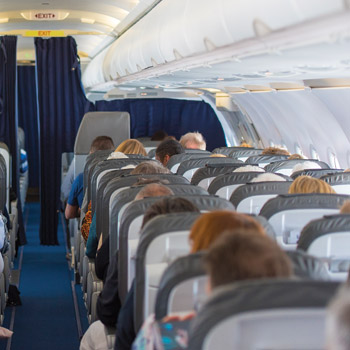A pre-flight check for patients
People with cardiopulmonary or hematologic disorders can be affected by the hypobaric environment aboard an aircraft, so they should undergo preflight evaluation before lift-off.
Deciding whether it's safe for a patient to fly can be tricky, due to limited evidence and variation (or in some cases, total absence) of guidelines.
ACP Member Yelena Burklin, MD, strived to make such decisions “more comfortable” for physicians during her session, “No Fright in Flight,” at Hospital Medicine 2019, held in National Harbor, Md., in March.

“Passenger aircraft cabins are pressurized to an altitude of 5,000 to 8,000 feet above sea level. For healthy individuals, that small change in barometric pressure does not cause a significant change in their partial oxygen pressure [PaO2] and oxygen saturation. However, for people with cardiopulmonary or hematologic disorders, who function at a lower partial oxygen pressure, the hypobaric environment aboard an aircraft makes a big difference, further reducing their PaO2” said Dr. Burklin, who is a hospitalist and assistant professor of medicine at Emory University in Atlanta.
Patients with pulmonary disease should undergo preflight evaluation if they have a baseline PaO2 less than 70 mm Hg, hypercapnia, or abnormal pulmonary function tests, she advised. To evaluate the risk of hypoxia, use predictive equations, hypobaric testing (if you happen to have a chamber available), or normobaric testing, also known as a hypoxia challenge test or hypoxia altitude simulation test.
“Normobaric hypoxic testing is considered to be the most practical and easy to perform, even though it does not determine the level of titration that will be required for those who require oxygen supplementation,” Dr. Burklin said. During a hypoxia challenge test, simply have the patient breathe air with a fraction of inspired oxygen of 15% for 20 minutes, and then measure the partial arterial oxygen pressure to determine the need for oxygen supplementation.
If the result is below 50 mm Hg, the patient should be on oxygen during the flight. Patients have the right to receive supplemental oxygen on all flights departing from or arriving in the U.S., but they must provide the airline with at least 48 hours' notice and sign a waiver, and Dr. Burklin advised that physicians should provide a note of necessity. Informed consent should also be obtained, and patients need to be warned that their oxygen has to be pre-booked with concentrators fully charged before travel, she added.
Other travel advice for patients with chronic obstructive pulmonary disease is to bring their bronchodilator and prednisone on board. Those who use continuous positive airway pressure (CPAP) should verify in advance that the machine is compatible with the electrical current at their destination and is functional at altitude (if patients are planning to use the device in flight).
A variety of patients with cardiovascular disease also require in-flight oxygen. “If the patient uses supplemental oxygen at baseline altitude, they should continue using it in flight. The airflow rate will typically double during the flight,” said Dr. Burklin.
Other indications for supplemental oxygen are class III heart failure with pulmonary hypertension and cyanotic congenital heart disease, Dr. Burklin added. She noted that there are several cardiovascular conditions that require hypoxic challenge testing before clearing the patient to fly and when in doubt, it is reasonable to test fitness to fly.
The British Thoracic Society issued recommendations on managing passengers with stable respiratory disease planning air travel in 2011, but they are mostly derived from case series and expert opinions, so physician discretion is advised, Dr. Burklin added.
Patients with more severe cardiovascular disease are on the no-fly list. That includes unstable angina, severe decompensated heart failure, uncontrolled hypertension, uncontrolled arrhythmias, Eisenmenger syndrome, and severe symptomatic valvular heart disease.
Other patients may just need to delay travel. After an uncomplicated myocardial infarction (MI), guidelines recommend not flying for two to three weeks. “The data have researched from three days to eight weeks, so it's a very broad spectrum of time where we can disallow travel,” she said. For complicated MI, wait six weeks; for coronary artery bypass grafting, wait 10 to 14 days; and after a stroke, wait two weeks.
Patients with pacemakers should carry a card identifying the type of pacemaker or implantable cardioverter defibrillator they have, as well as a copy of their electrocardiogram (EKG). “A copy of an EKG prior to pacemaker insertion would be helpful, as it identifies pre-existing arrhythmia in case the device malfunctions during the flight,” Dr. Burklin said.
Shifting from the heart to the brain, she reviewed neurological contraindications to flight, including seizure in the past 24 hours, cerebrospinal fluid leak, and intracerebral hemorrhage before clearance from a neurologist or neurosurgeon. For patients with neuromuscular diseases, the hypoxic challenge is recommended. “Delirium and psychosis should be controlled. Substance or alcohol detoxification should be complete,” she advised.
Speaking of medication, patients who take insulin and travel across several time zones may need to alter their regimens. “When travelling westbound, our day becomes longer. The amount of insulin the patients might require goes up. Eastbound, less insulin may be required on the day of travel as the day shortens,” explained Dr. Burklin. Patients may need to adjust their insulin dosing during the first one or two days upon arrival, based on blood glucose levels.
Some uncertainty exists in in-flight hematology, Dr. Burklin said. Guidelines for airline travel recommend supplemental oxygen for patients with sickle cell disease, but most patients do not follow this in her experience. Flying should be avoided for 10 days after a sickle cell crisis. As for anemia, patients with a hemoglobin level below 8.5 g/dL have historically been advised against taking to the air, especially after surgery. “Now we have new guidelines with a much more restrictive threshold for transfusion, so take it with a grain of salt,” she said.
There are some other postoperative contraindications. Plastic surgery patients should wait a week or two, and endoscopic procedures, including colonoscopy, require a 24-hour wait, to reduce the risk of trauma with the expanding volume of gas under the hypobaric conditions, Dr. Burklin said. Patients can develop a spinal headache from epidural anesthesia or lumbar puncture up to a week later, so they should stay on the ground for that time.
On the subject of headaches, physicians should use their clinical judgment to evaluate the risks faced by patients with sinus infections. To avoid decompression illness after a diving trip, especially in patients who've been diving several times per day, make the last day of a trip dive-free, she said.
Additional recommendations include using humidifiers and suction devices during flight for patients with tracheostomy, laryngectomy, or vocal cord paralysis. Pregnant women shouldn't fly if they have first-trimester bleeding or are more than 36 weeks pregnant. Women who are one to two weeks postpartum should avoid flying as well. Guidelines recommend waiting two to three weeks after resolution of a pneumothorax before flying.
The recommendations may sound complicated, but a lot of them can be summed up pretty simply, according to Dr. Burklin. “Do not travel with anything uncontrolled, decompensated, exacerbated, or untreated,” she said.





